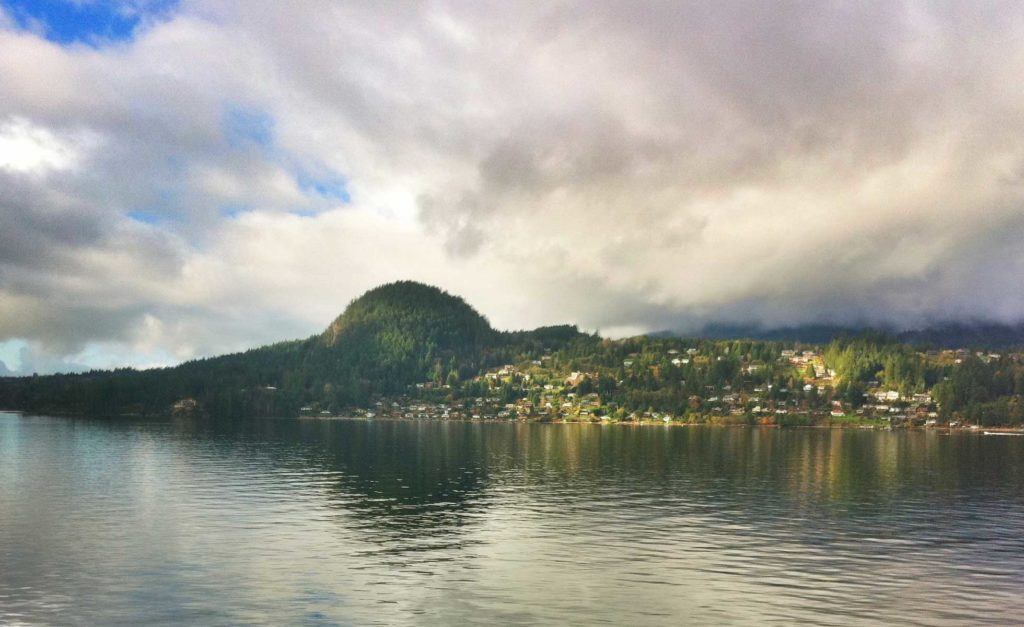
Gibsons, B.C., became the first municipality in North America, and possibly in the world, to consider nature as an asset and give natural assets the same consideration as traditional capital assets. (Photo: Bob Cotter via Flickr)
In recent years, communities throughout Canada have experienced large-scale flooding and coastal erosion. On the East Coast, Pointe-du-Chêne, New Brunswick, saw damage to buildings and beaches, including Parlee Beach, a popular tourist destination and provincial park. On the West Coast, the Town of Gibsons, B.C. — where the iconic Beachcombers TV series was filmed — wanted to plan for the increased risk of sea-level rise and storms predicted by climate models.
Since 2018, we have worked together with the Municipal Natural Assets Initiative to quantify the services natural assets offer, particularly those that provide flood and erosion protection from coastal storms. We also saw a need to develop and pilot a modelling tool that coastal communities could use to understand and compare alternative natural asset management solutions to rising storm surges and coastal erosion.
Together with Gibsons and Pointe-du-Chêne, the MNAI partnership took the first step in developing the computer modelling tool we call the Coastal Toolbox, bringing natural assets methods to coastal issues. This allowed us to evaluate the merits of natural assets (e.g., coastal vegetation or beach sediments) alongside grey infrastructure (e.g., levees, and seawalls). We took existing modelling tools and refined them to reflect the Canadian context.
Through the guidance of the DSF and MNAI we gained an increased appreciation for the complex coastal processes that impact flooding and erosion in Pointe-du-Chêne, and the increased risks the community faces with climate change.
James Bornemann, Geomatics Analyst, Southeast Regional Service Commission
More particularly, we wanted to see how nature could be a more useful tool to prepare for more damaging storms, especially in combination with human-engineered infrastructure. The large storms and tides expected to hit Gibsons and Point-du-Chêne are even more reason to explore cost-effective, natural ways to withstand extreme climate change.
We found that a single severe storm in Pointe-du-Chêne could result in up to $42.9 million in damages. Understanding the potential costs would support more informed decision-making at the community level on the appropriate incorporation of green infrastructure and natural assets within development plans. Nationally, the need is growing to “climate-proof” our infrastructure and ensure that it is more adaptable to a changing climate. Canada’s Disaster Mitigation and Adaptation Fund commits about $2 billion over 10 years “to invest in structural and natural infrastructure projects to increase the resilience of communities that are impacted by natural disasters triggered by climate change.” But climate-related infrastructure damage over just the past three years is estimated to be more than double that (about $4.5 billion).
The two pilot studies in the Town of Gibsons and Pointe-du-Chêne were a useful first step in developing a tool that could help communities prepare for climate change by better understanding what benefits different natural asset solutions can bring. The results reinforce the value of community strategies and providing evidence to support actions that reduce climate risks in coastal communities. We saw evidence that natural assets management as simple as shoreline and eelgrass planting and beach nourishment provide substantial erosion-reduction benefits. In Pointe-du-Chêne, these improvements can generate long-term benefits from reduced erosion ranging from 40 to 60 per cent (avoided costs equal to about $8 to $11 million). We have yet to quantify the erosion-reduction benefits in the case of Gibsons, but proxy indicators suggest that natural assets have the potential to reduce erosion vulnerability as well as offering a range of co-benefits for both communities (e.g., habitat provision or aesthetic appeal).
The project helped us understand the role of coastal infrastructure to provide protection from storm surges and coastal erosion. Project results will inform our own restoration work over the coming years, and we hope to have created a replicable model for other local governments to follow.
Michelle Lewis, Natural Assets Technician, Town of Gibsons
We saw that these same natural assets were less effective at mitigating coastal flooding. However, further research and refinements to the model will help to better assess how other coastal natural assets options (e.g., lagoons) can safeguard against more severe weather events. Simple measures can reduce risks in the short term while we plan other longer-term measures to reduce climate risks on coastal infrastructure and communities.
Increasingly we see human-built structures failing when faced with climate change’s bigger and more frequent storms. Coastal communities have learned to live alongside the ocean for centuries, but a destabilized climate is making life in these beautiful places more difficult and unpredictable than ever.
As we continue to bring to light the value — not just monetary, but intrinsic — of our natural assets, we also look to see how management of coastal ecosystems can mitigate the risks of storm surges and floods. Our deep dive into these two coastal communities showed us how important natural assets are to coastal communities, and illustrated the need for continued assessments of nature-based solutions for climate adaptation.
Our Work
Always grounded in sound evidence, the David Suzuki Foundation empowers people to take action in their communities on the environmental challenges we collectively face.



